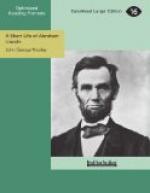While these events were occurring in Maryland and Virginia, the remaining slave States were gradually taking sides, some for, others against rebellion. Under radical and revolutionary leadership similar to that of the cotton States, the governors and State officials of North Carolina, Tennessee, and Arkansas placed their States in an attitude of insurrection, and before the middle of May practically joined them to the Confederate government by the formalities of military leagues and secession ordinances.
But in the border slave States—that is, those contiguous to the free States—the eventual result was different. In these, though secession intrigue and sympathy were strong, and though their governors and State officials favored the rebellion, the underlying loyalty and Unionism of the people thwarted their revolutionary schemes. This happened even in the northwestern part of Virginia itself. The forty-eight counties of that State lying north of the Alleghanies and adjoining Pennsylvania and Ohio repudiated the action at Richmond, seceded from secession, and established a loyal provisional State government. President Lincoln recognized them and sustained them with military aid; and in due time they became organized and admitted to the Union as the State of West Virginia. In Delaware, though some degree of secession feeling existed, it was too insignificant to produce any note-worthy public demonstration.
In Kentucky the political struggle was deep and prolonged. The governor twice called the legislature together to initiate secession proceedings; but that body refused compliance, and warded off his scheme by voting to maintain the State neutrality. Next, the governor sought to utilize the military organization known as the State Guard to effect his object. The Union leaders offset this movement by enlisting several volunteer Union regiments. At the June election nine Union congressmen were chosen, and only one secessionist; while in August a new legislature was elected with a three-fourths Union majority in each branch. Other secession intrigues proved equally abortive; and when, finally, in September, Confederate armies invaded Kentucky at three different points, the Kentucky legislature invited the Union armies of the West into the State to expel them, and voted to place forty thousand Union volunteers at the service of President Lincoln.
In Missouri the struggle was more fierce, but also more brief. As far back as January, the conspirators had perfected a scheme to obtain possession, through the treachery of the officer in charge, of the important Jefferson Barracks arsenal at St. Louis, with its store of sixty thousand stand of arms and a million and a half cartridges. The project, however, failed. Rumors of the danger came to General Scott, who ordered thither a company of regulars under command of Captain Nathaniel Lyon, an officer not only loyal by nature and habit, but also imbued with strong antislavery convictions. Lyon found valuable support in the watchfulness of a Union Safety Committee composed of leading St. Louis citizens, who secretly organized a number of Union regiments recruited largely from the heavy German population; and from these sources Lyon was enabled to make such a show of available military force as effectively to deter any mere popular uprising to seize the arsenal.




